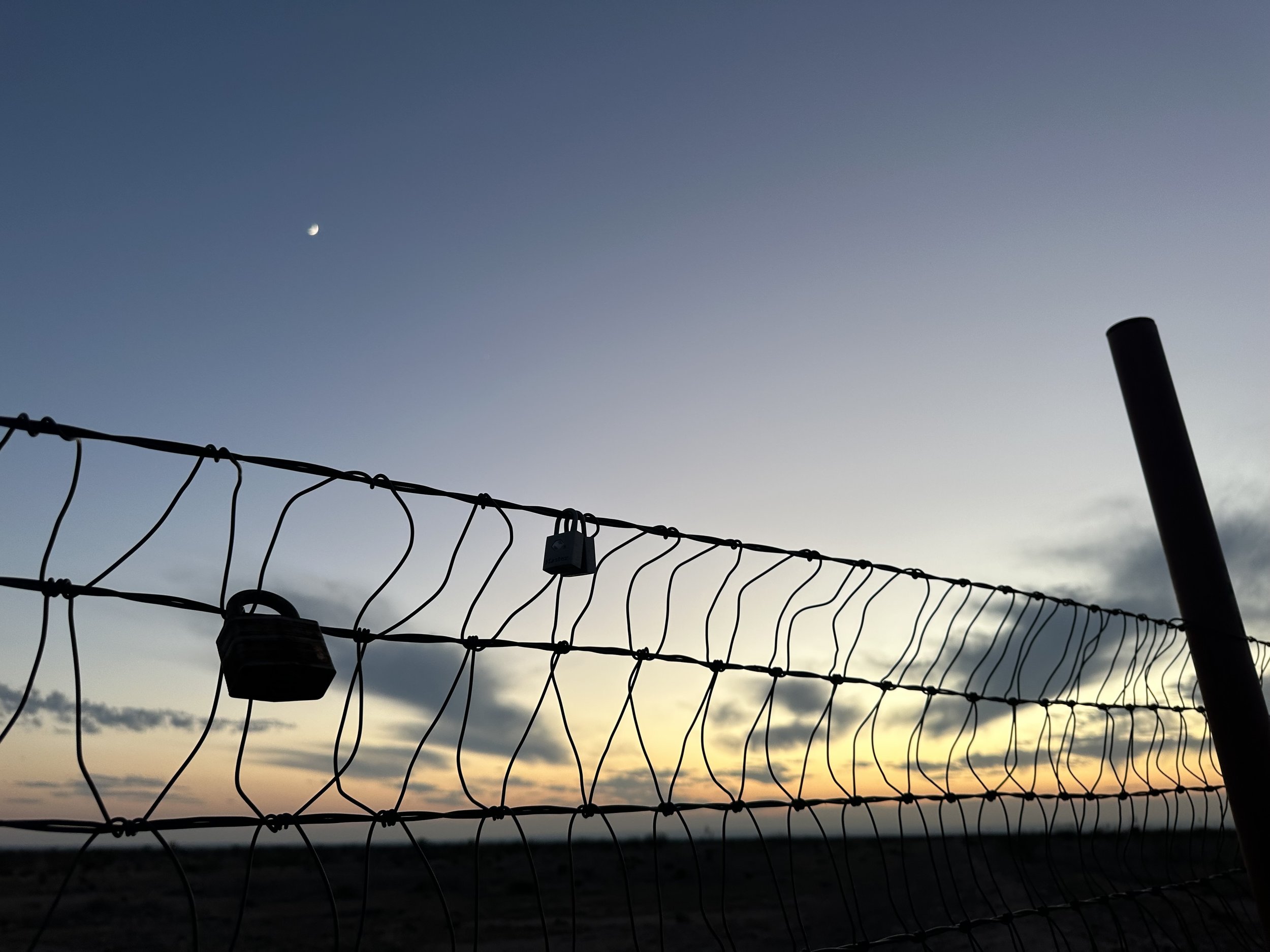Practice Resurrection
This post is by Jenna Blyler.
The blustery desert casts us into a grainy, silent film. The brittle Texas switchgrass beats at my throat the way I imagine the coffle of stars above me clawing desperately at Heaven’s winter gates.
What I see across the plains resembles emulsion defects on a film roll—nomadic lightbulbs blinking drowsily against the night sky. It’s half-past midnight when my ruddy, restless dog looks at me as if asking “why” and “when,” while she catalogs an encyclopedia of new “whats” and “wheres”. I wonder if I can believe in the possibility of aliens and not in God, or in the absolutes of science and not myself.
We are traveling to a conference about risk, staying in Marfa, Texas for three nights on the way. Marfa is an artistic whistle-stop with a scrappy interior and a kaleidoscope of perspective made popular in the 70s by the minimalist architect Donald Judd. We are visiting because a friend felt a quiet but profound resonance here. His response compelled me to see it for myself, to understand what moved him so deeply as a scientist, photographer, and writer. It felt like “practicing resurrection,” to roam for renewal, as Wendell Berry commanded in his Mad Farmer Manifesto.
Over time I’ve noticed that scientists often distinguish themselves from the creative—whether out of insecurity, pretension, or because their mother told them to, as one of my professors recently mentioned “in jest.” His mother told him he was not the creative child since his siblings were architects and musicians—I suppose the more self-evident sort. He’s a prominent psychologist who conjures up countless questions to test, but when it comes to the word “creative”—he flinches, as if it were a bruise still tender after all these years. I responded to him sympathetically, “You’ve built models, applied theories in new ways, and written papers and books. Of course you are creative!” But privately, I too tremble at the no-man’s land of legitimacy wedged between “science” and “art”—which side am I on? Must there be one?
Of course, there are myriad examples of professional scientists and artists. Brian May, for instance, is Queen’s lead guitarist who holds a Ph.D. in astrophysics. Leonardo da Vinci, renowned for the Mona Lisa, also invented the parachute and calculator. Santiago Ramón y Cajal, considered the father of modern neuroscience, discovered the independence of the neuron and captured it in detailed drawings long before medical imaging. Those illustrations are now featured in “The Beautiful Brain” exhibit at NYU. I am not writing about the similarities of science and art because it is an unusual observation, rather, out of wonder of why some of us see these worlds separately and how I’ve also limited myself by thinking this way. I’m always so nervous about writing the wrong thing.
I wonder this while watching the Marfa Lights and my own ugly rules start reeling like a horror filmstrip jumping frames. Fumbling for the brake, I search the etymology of the word “creativity” and learn of its Greek root “poiesis”. It means—to make, to bring into existence (the mother of “poet”). Although science and art differ slightly in outcome, their processes seem nearly identical to me—both require tinkering, bravely acting on unusual ideas, building on what exists to generate new understanding. The endless, somewhat reductionist business of directories, labels, and declared certainties in the field of science seem to sometimes distract from this purpose and frazzle the already apologetic atmosphere of academia. Maybe “creative” feels uncomfortable to scientists because it’s seen as separate from our merit—as if trying too many things makes it look like splatter-paint instead of meticulous lab notes. As if it matters.
I’m told this process is typical for students as we amateurly sort through which ideas are an “acceptable” sacrifice to the publishing gods. But if unchecked, I worry it could lead to a lifetime of self-doubt and self-restraint. I search for another Berry essay on this, “When science focuses solely on creating marketable products, it risks reducing nature, the body, and human life to resources to be exploited. Without seeing science as an art, we lose the broader, interconnected view essential for true understanding.”
This is on my mind in part because I am working on a project exploring the power of labeling. The language we use, in its subtlest shades, shapes how we perceive and respond to the world. Even the slightest shift in how we describe something can change how we approach it. Even if the words are synonyms. I think about my professor. What has he not done because he’s shackled himself to the term “scientist”? How much of our potential is restrained by the words we use to define ourselves?
I look at my dog amidst the Marfa Lights: aliens, God, science, us—still unlabeled. She remains unbothered by her undefined classification (even the etymology of “dog” is uncertain). We pack up and head out to join a San Franciscan artist at a barrel fire, who is the gallery host of Marfa Open. And I’m once more reminded of Wendell Berry’s words, “Some scientists, I think, are in this sense poets.”


